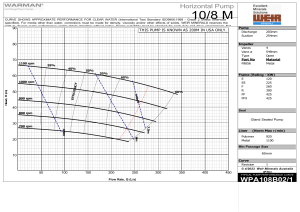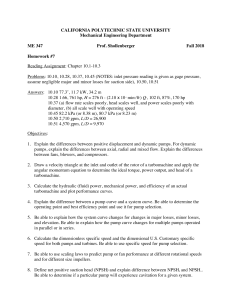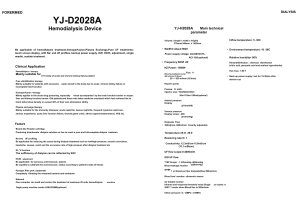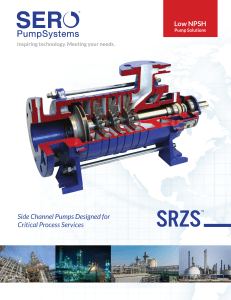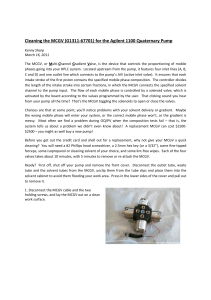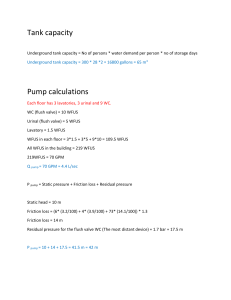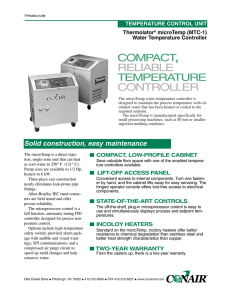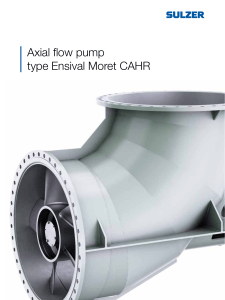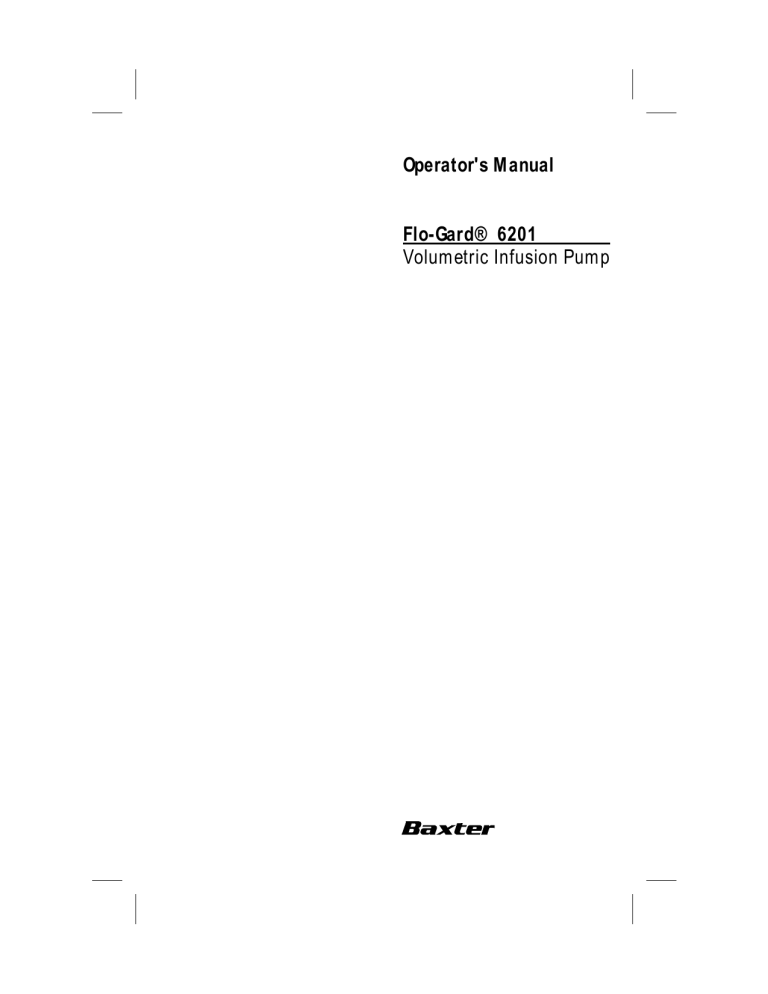
Operator's Manual Flo-Gard® 6201 Volumetric Infusion Pump Table of Contents Introduction .............................................................................................1 Physical Description...............................................................................3 Operating Instructions .........................................................................10 Precautions ......................................................................................10 Loading the Pump ............................................................................11 Starting a Primary Infusion ...............................................................14 Starting a Secondary Infusion ..........................................................17 Using Volume-Time Programming ...................................................18 Changing the Flow Rate While the Pump Is Running ......................20 The OPTIONS Key ...........................................................................21 Using the Manual Programmed Delivery Profile ..............................21 Using the Ramp Programmed Delivery Profile ................................24 Computer Control.......................................................................29 Computer Monitoring..................................................................30 Locking the Front Panel....................................................................30 Battery Powered Operation ..............................................................31 FLOW CHECK Information Display..................................................31 Cleaning and Storage ...........................................................................32 Alerts and Alarms ................................................................................33 Technical Specifications ......................................................................38 Configurable Options ...........................................................................40 Warranty and Service Information ......................................................45 Warranty ...........................................................................................45 Service Information ..........................................................................46 Change record 7-19-01-602 Original issue: 4/92 Rev. A: 6/92 Rev. B: 4/93 Rev. C: 11/94 Rev. D: 3/99 Page Revision Front cover i ii 1 2–11 12 13–14 15–38 39 40–46 Back cover 0 B D B 0 B 0 B C B D A zero in the “Revision” column indicates original issue. ii Rev. D Introduction The Flo-Gard® 6201 Volumetric Infusion Pump from Baxter can deliver a wide variety of fluids over a broad range of infusion rates. Its features include: • Uses only standard Baxter solution administration sets. • Configurable settings allow the pump to be customtailored to best suit the hospital's needs. • Computer control capability allows remote control or monitoring of the Flo-Gard® 6201 pump via a standard RS232-C interface. • Pumps a wide variety of fluids, including blood and fat emulsions. • Suitable for use in epidural administration. • Safety clamp automatically occludes the tubing when the pump door is opened. • Occlusion sensors detect both upstream and downstream restrictions. Sensitivity of the downstream occlusion sensor is selectable through the pump's configuration. • Flow check display shows resistance to flow. • Ultrasonic air-in-line detector. Sensitivity of the air detector is selectable through the pump's configuration. • The Programmed Delivery Profile (PDP) enables manual programming or ramped calculation of up to 10 sequential infusion programs for situations where multiple flow rates are indicated. • Slide clamp loading option provides flow shutoff when I.V. set is removed from the pump. • Locking control panel helps prevent patient tampering. Rev.B 1 2 • An independent secondary medication program. The pump automatically switches over to the primary program upon completion. • Volume-Time programming automatically calculates flow rate. • Automatic self-test routine checks for proper function before use. • Five-hour memory retains infusion data after power-off. • Easily replaceable fuse, battery, and power cord. Physical Description All front panel items are shown in Figure 1. Front Panel ITEM FUNCTION 1. Message display Shows all alarm and alert messages. 2. BACK LIGHT key Backlights the displays when pressed. Pressing the key again turns the backlight off. If the pump is running on battery power, the backlight remains on for 60 seconds each time the BACK LIGHT key is pressed. 3. SILENCE key Temporarily silences an audible alarm or alert for two minutes, unless another alarm occurs within the two minute silence period. All messages remain displayed until the cause of the alarm or alert is alleviated. 4. NEXT legend Lights when the TOT VOL/STATUS key is functioning as the NEXT key. 5. TOT VOL/STATUS key Displays total volume delivered when pressed. The key is also used to advance to the next step when programming a delivery profile. (See NEXT legend, item 4 above.) 6. CLEAR TOT VOL key Resets the total volume delivered to zero when the pump is stopped. 7. TIME key Enters the time over which an infusion is to take place during Volume-Time programming. 8. STOP key Stops the pump until further instructions are given. The message STOPPED appears when the key is pressed. An alert will sound if the pump is stopped for more than two minutes. Clears all programming alerts while pump is running. 9. Door latch Opens and closes pump door for I.V. set loading and removal. 10. ON-OFF/CHARGE key Turns pump on and off. The internal battery charger remains on regardless of the ON-OFF/CHARGE key as long as the pump is plugged in. 11. Battery icon Lights when the pump is operating on battery power. 12. Plug icon Always lit when pump is plugged in and battery is charging. 3 1 3 2 4 5 6 27 7 26 8 25 BACK LIGHT ALARM PUMPING ALERT 24 SILENCE NEXT TOT VOL STATUS 23 9 CLEAR TOT VOL 22 21 20 19 PRI RATE PRI VTBI PRI START 7 4 1 . 8 5 2 9 6 3 0 CLR SEC RATE SEC VTBI SEC START OPTIONS P U S H TIME 11 STOP 12 ON OFF CHARGE COMPUTER CONTROL MONITOR Flo-Gard® 6201 VOLUMETRIC INFUSION PUMP 18 17 16 15 14 13 Figure 1. Front View 4 10 Front Panel ITEM FUNCTION 13. MONITOR legend Lights when the pump is being monitored by a computer. 14. COMPUTER CONTROL legend Lights when the pump is being controlled by a computer. 15. SEC START key Starts the delivery of the secondary solution. 16. SEC VTBI key Allows programming of the secondary VTBI. 17. OPTIONS key Allows a computer to control the pump and permits use of the Programmed Delivery Profile (PDP). If Computer Control and/or PDP are available, the OPTIONS key is lit. 18. SEC RATE key Allows programming of the secondary infusion rate. 19. CLR key Clears any programming values currently being entered. 20. Numerical keypad Programming values and decimal point are entered with these keys. 21. PRI VTBI key Allows programming of the primary VTBI. 22. PRI RATE key Allows programming of the primary infusion rate. 23. PRI START key Starts the primary infusion. 24. Main display Shows rate, volume to be infused (VTBI) and total volume infused for primary and secondary infusion programs. The decimal point is displayed as an underscore (example: 99_9). 25. ALARM LED Red LED that blinks during an alarm, accompanied by a message display and a repeated sequence of three tones. An alarm indicates that the pump requires immediate attention. 26. PUMPING LED Green LED which is constantly lit during pumping. 27. ALERT LED Yellow LED illuminates during alert conditions, accompanied by a message display and a repeated single tone. An alert indicates that the pump needs timely attention. 5 The pump head features are shown in Figure 2. Pump Head Features ITEM 6 FUNCTION 1. Upstream occlusion sensor Detects a complete tubing restriction upstream of the pump. 2. Pumping fingers The linear peristaltic pump mechanism consists of cam-driven pumping fingers which successively manipulate the tubing against the backplate, resulting in fluid movement in a downward direction. 3. Downstream occlusion sensor Detects tubing restrictions downstream of the pump. The sensitivity level can be adjusted to suit the needs of the hospital through the pump's configuration. 4. Air sensor Detects air bubbles in the tubing. The sensitivity is adjustable via the pump's configuration. 5. Safety clamp Prevents accidental fluid flow by automatically occluding the tubing whenever the pump door is opened. 6. Slide clamp slot When the slide clamp loading option is enabled, the I.V. set's slide clamp must be inserted into this slot. The operator must push the slide clamp into the slot to occlude the tubing before the I.V. set can be removed from the pump. The slide clamp loading option is selectable through the configuration. 7. Slide clamp spring retainer If your hospital has not selected the slide clamp loading option, this spring retainer will be inserted into the slide clamp slot, preventing the insertion of the slide clamp into the slot. 1 2 3 4 5 6 7 Figure 2. Pump Head Features 7 The following items are located on the rear of the pump and are shown in Figure 3. Rear Panel Features ITEM 8 FUNCTION 1. I.V. pole clamp Secures the pump to the I.V. pole. 2. Power cord strap Stores the power cord. 3. Audio speakers For generation of alarm and alert tones. 4. Battery compartment Allows access to the battery by authorized service personnel only. 5. VOLUME knob Adjusts volume of alert and alarm tones. The alarm and alert tones cannot be turned completely off. 6. PANEL LOCK switch Disables all front panel keys except BACK LIGHT and TOT VOL/STATUS when pressed. 7. Power cord Supplies AC power to the pump when plugged into hospital-grade earth-grounded outlet. Removable by authorized service personnel only. 8. Fuse Fuse compartment is located behind power cord retention strain relief plate. 9. COMMUNICATIONS PORT Standard RS-232C port that allows the pump to communicate with a computer. 2 1 3 4 9 COMMUNICATIONS PORT VOLUME PANEL LOCK (PUSH) 6 8 5 7 Figure 3. Rear of Pump 9 Operating Instructions Precautions General 10 • DANGER—Possible explosion hazard if used in the presence of flammable anesthetics. • Operate pump from 115 V, 60 Hz, hospital-grade earth-grounded outlet only. • Though the factory-supplied configuration settings are suitable for most therapies, the operator and hospital professionals should verify that the pump's settings are appropriate for their clinical applications. • Use only with standard Baxter soft tubing administration sets with an “s” designation. • Read and understand this manual before using the Flo-Gard® 6201 pump. • When infusing fluid through a central line catheter, Baxter recommends that sets with a Luer lock adapter be used. • If using a filter set, use only filters which are suitable for use with infusion pumps. Read and follow instructions of the filter to be used. • To use the automatic piggyback function, use only Continu-Flo® sets from Baxter as the primary line with a compatible secondary set for the secondary line. Epidural Administration • Epidural administration of anesthetics is limited to short-term infusion (not to exceed 96 hours) with indwelling catheters specifically indicated for shortterm anesthetic epidural drug delivery. • Epidural administration of analgesics is limited to use with indwelling catheters specifically indicated for either short-term or long-term analgesic epidural drug delivery. • To prevent infusion of drugs that are not indicated for epidural use, do not use administration sets that incorporate injection sites during epidural delivery. • It is strongly recommended that pumps used for epidural drug delivery be clearly differentiated from pumps used for other routes of administration. • WARNING—Epidural administration of drugs other than those indicated for epidural use could result in serious injury to the patient. Loading the Pump 1. Plug the pump in. Plug power cord into a 115 V, 60Hz grounded outlet, unless temporary battery power is required. The plug icon lights whenever the pump is plugged in. When the pump is not plugged in and is battery-powered, the battery icon will light. 2. Prepare solution. Prepare fluid container and administration set according to the directions accompanying the products. Prime the set. Ensure all air is expelled from the set. 11 3. Close set regulating clamp. 4. Open pump door. Raise pump door latch to horizontal position and pull door open. 5. Load the set. a. Press SAFETY CLAMP to open position. b. If your hospital has enabled the slide clamp loading feature, insert the slide clamp on the I.V. set fully into the slot, so that it is flush with the pump housing. (See Figure 4.) If the slide clamp loading feature is not enabled, a black spring retainer occupies the slide clamp slot and the slide clamp cannot be inserted. Proceed to step c. Note: During an emergency, in the alert mode, the pump will operate without inserting the slide clamp. An alert tone will sound until the slide clamp is inserted or the SILENCE key is pressed. In the alarm mode (software versions later than 1.08), the pump will NOT start and an alarm tone will sound if the slide clamp is not loaded.) c. Load the tubing through the guide channel from bottom to top as shown in Figure 4. d. Ensure that the tubing is loaded straight through the pump mechanism tubing guides and safety clamp. e. Ensure that the tubing is touching the pumping fingers before closing the pump door. Slide clamp in slot Figure 4. I.V. Set Loading 12 Rev.B 6. Close pump door. If resistance is felt when closing the door, check for misloaded I.V. set. 7. Open set regulating clamp completely. a. Verify that no drops are falling in drip chamber. If flow is observed, close regulating clamp, recheck I.V. set loading and verify that the proper administration set is being used. b. If flow is again observed, do not use the pump. Have it inspected by service personnel. Note: Always close the administration set regulating clamp(s) before opening pump door and removing set. 8. Attach set to I.V. access site. 9. Turn pump on by pressing the ON/OFF CHARGE key. Verify that the pump performs the following self-test: a. All segments of both displays appear momentarily. b. Three separate audible tones sound. c. If a Hospital Area Designator (HAD) has been programmed into the pump, it appears for 3 seconds. d. The occlusion detection level is momentarily displayed in the message display (LEVEL 1, 2, or 3), followed by AUDIBLE SWITCHOVER if the Audible Switchover option is enabled. e. If Auto Restart and Flow Check are both enabled, the message AUTO RESTART appears for one second following the occlusion detection level display. 13 f. If the pump is plugged into an AC outlet, the plug icon is lit. If the pump is running on battery power, the battery icon is lit. g. If the message INSERT SLIDE CLAMP appears when you close the door, the slide clamp loading option is enabled. Close the I.V. set's regulating clamp, open the door, and insert the I.V. set's slide clamp fully into the slide clamp slot located below the safety clamp. Close the door and open the regulating clamp. 10. Set VOLUME knob on the rear of the pump to the desired level. Starting a Primary Infusion 1. Set primary flow rate as follows: a. Press PRI RATE. b. Program desired flow rate (in mL/hr) on keyboard. Zero cannot be entered as the first digit. c. A selected flow rate higher than the allowable maximum results in the message Hi appearing in the PRI RATE display. To correct a mistake, press CLR or PRI RATE again and reenter correct rate. The flow rate is displayed in the main display. 2. Set primary volume to be infused. 14 a. Press PRI VTBI. b. Program desired VTBI (in mL) on keyboard. Set VTBI equal to the amount of fluid in the container or less if desired. c. To correct a mistake, press CLR or PRI VTBI again and re-enter the correct VTBI. The VTBI is displayed in the main display. 3. If necessary, reset the volume previously infused to zero. Note: Press the CLEAR TOT VOL key. Always verify programmed information prior to starting the pump. 4. Start the pump. a. Press PRI START. The green PUMPING LED lights and a moving bar appears next to the flow rate setting. b. If the alarm (software versions later than 1.08) or the alert tone sounds with the message INSERT SLIDE CLAMP when you press PRI START, the slide clamp loading option is enabled and the slide clamp has not been loaded into the slide clamp slot. Close the I.V. set's regulating clamp, open the door, and insert the I.V. set's slide clamp fully into the slide clamp slot located below the safety clamp. Close the door and open the regulating clamp. c. Confirm flow by checking for drops in the I.V. set drip chamber. 5. To stop an infusion before it is complete: Rev.B a. Press the STOP key. 15 b. The PUMPING LED goes out and STOPPED appears in the message display. c. If the pump is not restarted within two minutes, an audible alert sounds. 6. To restart an infusion, press the PRI START key. 7. When the infusion completes: When the pump has delivered the selected volume, it sounds an alert tone and switches to a KVO (Keep Vein Open) rate of 5 mL/hr or the current rate setting, whichever is lower. 8. Remove set from pump as follows: a. Press the STOP key. b. Close administration set regulating clamp. c. Open pump door. d. If the slide clamp loading option is enabled, press the slide clamp fully into its slot. e. Press the SAFETY CLAMP to the open position. f. Check that no fluid is flowing in set, then remove set from pump. g. To turn the pump off, press the ONOFF/CHARGE key. 16 Rev.B Starting a Secondary Infusion 1. Prepare secondary fluid container and administration set. a. To perform automatic piggybacking, a Continu-Flo® set from Baxter must be used as the primary set. b. Follow directions accompanying the products. c. Ensure all air is expelled from the secondary set. 2. Attach the secondary set to the injection site of the primary set above the pump. 3. Lower primary container with the hanger accompanying the secondary set. 4. Set secondary flow rate as follows: a. Press SEC RATE key. The right-hand side of the main display now shows secondary infusion data. b. Enter desired flow rate (in mL/hr) for the secondary solution. c. To correct a mistake, press CLR or SEC RATE again and re-enter the correct value. 5. Set secondary volume to be infused as follows: a. Press the SEC VTBI key. b. Enter the desired fluid amount (in mL) on the keyboard. Set VTBI equal to the volume of fluid in the container. Rev.B 17 c. To correct a mistake, press CLR or SEC VTBI again and re-enter the correct value. 6. Open secondary set on/off clamp. Check also that the primary set regulating clamp is open. 7. Press SEC START to begin the infusion. a. Verify that drops begin falling in the secondary set drip chamber only. b. Verify that the secondary program is displayed. c. When the VTBI of the secondary program reaches zero, the pump will revert to the primary program. When this happens, if the primary flow rate is set above 999 mL/hr, be sure to close the secondary set on/off clamp. Using Volume-Time Programming Volume-Time Programming allows you to select a VTBI, and the amount of time over which the infusion is to take place. The pump then automatically calculates the flow rate. If the calculated rate is outside the pump's capabilities, the message Hi or Lo appears as appropriate. VolumeTime Programming can be used for primary and secondary infusions. In the procedure below, the keys to press for secondary programming are shown in parentheses. 1. Press the ON-OFF/CHARGE key. 18 Rev.B 2. Press the PRI VTBI key (or SEC VTBI, if you are programming a secondary infusion). 3. Program the desired VTBI on the keyboard. To correct a mistake, press the and re-enter the correct VTBI. CLR key 4. Press the TIME key. Enter To correct a mistake, press the CLR key the amount of time (up or TIME key again and re-enter the corto 99 hours and 99 minrect time. utes) over which you wish the infusion to take place. 5. Press the PRI RATE (or SEC RATE) key. a. The pump calculates the flow rate required to deliver the desired VTBI in the specified time period. b. If the calculated flow rate is higher than the pump's capabilities, the message Hi is displayed. To correct a Hi message, repeat the procedure from step 2 and enter a longer time period if appropriate. c. If the calculated rate is too low, the message Lo is displayed. To correct a Lo message, repeat the procedure from step 2 and enter a shorter time period if appropriate. 6. Verify that the calculated rate is acceptable before pressing PRI START (or SEC START) to begin the infusion. Rev.B 19 Changing the Flow Rate While the Pump Is Running To change the primary or secondary flow rate during the course of an infusion, follow the procedure given below. The keys to press for secondary infusions are shown in parentheses. 1. Press PRI RATE (or SEC RATE) while pump is running. NEW RATE appears in the message display and an alert tone sounds periodically. 2. Enter the new flow rate on the keyboard. a. If the primary rate is changed above 999 mL/hr, ensure that the secondary set on/off clamp is closed. b. If a new rate higher than the allowable maximum is entered, the message Hi appears in the PRI RATE display. 3. Press PRI START. 20 The pump begins delivering fluid at the new rate, the alert tone stops, and the NEW RATE message disappears. Rev.B The OPTIONS Key The OPTIONS key is used to place the pump into Computer Control mode and to set a Programmed Delivery Profile (PDP). The OPTIONS key is active only when set in the pump's configuration. Pressing the OPTIONS key selects Computer Control and/or PDP. The PDP has two methods of programming. The manual Program Delivery method allows you to manually program an infusion with up to 10 different steps. The Ramp PDP method allows you to program a ramped infusion by entering volume and time parameters. The availability of the PDP programming option is dependent upon the pump's configuration. Note: If the word OPTIONS is not visible when the pump is powered on, you cannot use computer control or PDP. Consult qualified hospital biomedical personnel regarding the appropriateness of the pump's settings. Using the Manual Programmed Delivery Profile The manual Programmed Delivery Profile (PDP) allows you to program an infusion with up to 10 different steps. The pump automatically changes to the next programmed rate once the VTBI of a step has been delivered. To use the 10 step manual Program Delivery Profile, proceed as follows: 1. Verify that the OPTIONS key is lit. a. If OPTIONS is not illuminated, your pump is not configured for PDP. b. Consult with authorized hospital personnel if you have questions regarding the appropriateness of your pump's configuration settings. Rev.B 21 2. Place the pump into Program Delivery Profile mode by pressing the OPTIONS key. Press the key until the message PGM DELIV appears and the NEXT legend over the TOT VOL/STATUS key is illuminated. The pump is now in PDP mode for an infusion with up to 10 different steps. If RAMP PDP appears, the pump is configured for automatic ramped delivery. Consult with authorized hospital personnel if you have any questions regarding the appropriateness of your pump's configuration. 3. Review previous Program Delivery steps. a. If a previously set Program Delivery Profile is stored in the pump's memory, STEP 1 appears in the message display and the rate and VTBI of the first programmed step appear in the main display. b. If you wish to clear the stored Programmed Delivery Profile, press the CLR key. The message CLEAR ALL? appears. Press the CLR key again to clear all Program Delivery rates and VTBIs. The CLEAR ALL? message disappears. c. If you wish to use the stored Programmed Delivery Profile, continue pressing the NEXT key to scroll through and review all steps of the Programmed Delivery Profile, until the first step is again displayed. Review each step to ensure that the Program Delivery rates and VTBIs are appropriate. 22 Rev.B d. To begin the Programmed Delivery Profile, press PRI START. The message REVIEW PDP appears if you have not completed reviewing the stored PDP. After you have reviewed all steps and pressed PRI START, the pump begins delivering fluid. Note: If you enter Programmed Delivery Profile mode and then try to start the pump without first entering a PDP, the message ENTER PGM appears on the second line of the message display. The message will disappear once you start to enter a PDP. 4. Modify previous Programmed Delivery steps. a. Press the NEXT key to reach the Program Delivery step you wish to modify. b. Press the key for the infusion parameter you wish to modify (PRI VTBI or PRI RATE). c. Enter the new value on the numerical keyboard. d. Press the NEXT key to lock in the programmed values and advance to the next step. e. Modify additional Program Delivery steps if desired. After reviewing or changing the last step, press NEXT again, until the first step is displayed. f. To begin the Program Delivery Profile, press PRI START. The pump will begin delivering fluid. 5. To program new manual Program Delivery steps: Rev.B 23 Note: When programming a PDP step, you must set one of the following combinations: Primary Rate and Primary VTBI, Primary VTBI and Time, or Primary Rate and Time. When Time is entered, Primary VTBI or Primary Rate must be entered first. The pump will then calculate the Primary Rate and display it when the PRI RATE or PRI VTBI key is pressed. a. Enter the desired values in the same way you would program a primary infusion. b. Press the NEXT key to lock in the programmed values and advance to the next step. c. Program all remaining steps (up to 10) in the same manner. After entering settings for the last step, press NEXT again, until the first step is displayed. d. To begin the Program Delivery Profile, press PRI START. The pump will begin delivering fluid. Pressing OPTIONS, PRI RATE, SEC RATE, or SEC VTBI causes the pump to drop out of manual Program Delivery Profile. The pump will switch to the KVO rate when it reaches a step that has a rate of zero. Using the Ramp Programmed Delivery Profile The Ramp PDP will allow you to program a ramped medication delivery by entering the Total VTBI, Delay Time, Run Time, Ramp Up Time and Ramp Down Time. The pump will automatically calculate flow rates to deliver the total VTBI over the selected time parameters. A sample Ramp PDP is shown in Figure 5. 24 Rev.B When the Ramp PDP is running the pump will display the rate and VTBI of each step, along with the time remaining until completion of the Ramp PDP. A message will indicate the current phase of the Ramp PDP (DELAY, RAMP UP, LEVEL DELV, RAMP DOWN). rate V6 V5 V7 V4 V8 V3 KVO rate V1 V9 V10 V2 STEP time delay time ramp up time ramp down time run time Figure 5. Sample Ramp Program Delivery Profile (PDP) PDP Phase Delay Time Description This is the time delay from the start of the infusion until the actual therapy begins. During this phase the pump delivers fluid at 5mL/hr KVO rate. Run Time This represents the total time of the Ramp PDP, excluding the delay time. Ramp Up This represents the time from the start of the therapy until the level delivery rate is achieved. Time Ramp Down This represents the time to taper off from the level delivery rate. After completion of the Ramp PDP the pump continues at the KVO rate. Time Rev.B 25 Note: If any of the entered parameters (Total VTBI, Run Time, Delay Time, Ramp Up and Ramp Down) are outside the pump's capabilities, the message Hi or Lo appears as appropriate on the main display. 1. Verify that the OPTIONS key is lit. a. If OPTIONS is not illuminated, your pump is not configured for PDP. b. Consult with authorized hospital personnel if you have questions regarding the appropriateness of your pump's configurations settings. 2. Place the pump into Ramp PDP by pressing the OPTIONS key. a. Press the key until the message RAMP PDP appears and the NEXT legend over the TOT VOL/STATUS key is illuminated. The pump is now in the PDP mode. If PGM DELIV appears, the pump is configured for manual Program Delivery. Consult with authorized hospital personnel if you have any questions regarding the appropriateness of your pump's configuration. 3. Review previous Ramp PDP parameters. a. If a previous Ramp PDP is stored in the pump's memory, TOTAL VTBI appears in the message display and a volume, in mL, appears in the main display. b. If you wish to use the stored Ramp PDP parameters, press the NEXT key to scroll and review through all parameters of the Ramp PDP, until the TOTAL VTBI message is again displayed. Review each parameter to ensure that the Ramp PDP parameters are appropriate. 26 Rev.B c. To begin the Ramp PDP, press PRI START. The message REVIEW PGM appears if you have not completed reviewing the stored Ramp PDP. After you have reviewed all parameters and pressed PRI START, the pump begins delivering fluid. Note: If you enter Ramp PDP and try to start the pump without first entering data, the message ENTER DATA appears on the second line of message display. The message will disappear once you start to enter data. 4. Modify previous Ramp PDP parameters. a. Press the NEXT key to reach the parameter you wish to modify. b. Press the CLR key to erase the previous parameter. c. Enter the new value on the numerical keyboard. d. Press the NEXT key to lock in the programmed value and advance to the next parameter. e. Modify additional parameters if desired. After reviewing or changing the last parameter, press NEXT again, until TOTAL VTBI is displayed. f. To begin the Ramp PDP, press PRI The pump will begin delivering fluid. START. 5. To program new Ramp PDP parameters: Note: Rev.B When programming a Ramp PDP, you must set values for Total VTBI and Run Time. Delay Time, Ramp Up and Down parameters are optional. If an optional parameter does not have a time entered, the pump will skip that section of the Ramp PDP during fluid delivery. 27 a. TOTAL VTBI appears in the message display. b. Press the CLR key to allow the entry of a new value. c. Enter the value on the numerical keyboard. d. Press the NEXT key to lock in the programmed value and advance to DELAY TIME. e. Press the CLR key to allow the entry of a new value. f. Enter the value on the numerical keyboard. g. Press the NEXT key to lock in the programmed value and advance to RUN TIME. h. Press the CLR key to allow the entry of a new value. i. Enter the value on the numerical keyboard. j. Press the NEXT key to lock in the programmed value and advance to RAMP UP. k. Press the CLR key to allow the entry of a new value. l. Enter the value on the numerical keyboard. m. Press the NEXT key to lock in the programmed value and to advance to RAMP DOWN. n. Press the CLR key to allow the entry of a new value. o. Enter the value on the numerical keyboard. 28 Rev.B p. Press the NEXT key to display TOTAL VTBI. q. To begin the Ramp PDP, press PRI START, the pump begins delivering fluid. 6. To resume an unfinished Ramp PDP: Note: If the pump is turned off while delivering a Ramp PDP, the user can resume the profile, where it was interrupted, if the pump is turned back on within one hour. After one hour, the Ramp PDP can only be started from the beginning. a. Turn the pump on by pressing ONOFF/CHARGE. An alert tone will sound and RESUME PDP appears in the message display if the pump is turned on within one hour of being turned off. b. Press PRI START to resume the Ramp PDP and the pump begins delivering fluid. The pump will switch to the KVO rate when the Ramp PDP has been completed. Computer Control The Computer Control option allows the pump to be controlled by a remote computer. Computer Control is an option made available through the configuration. When the pump is under computer control, the COMPUTER CONTROL legend on the front panel will be lit. Pressing any enabled key (other than PANEL LOCK, SILENCE, TOT VOL/STATUS, or BACK LIGHT) causes the pump to drop out of computer control. Rev.B 29 Computer Monitoring When the pump is set up for computer monitoring, information is gathered by a remote computer via the COMMUNICATIONS PORT. The computer connected to the pump does not control it; it simply monitors infusion data. The MONITOR legend on the front panel lights whenever the computer queries the pump for information. The pump is operated in exactly the same manner as if it were not connected to the computer. Locking the Front Panel The front panel can be locked during pumping to prevent tampering. It can be unlocked at any time. The TOT VOL/STATUS and BACK LIGHT keys are not affected by the lockout. This allows routine infusion data checks while the front panel is still locked. If the pump is stopped due to an infusion alarm or an opened door, the panel must be unlocked to restart the infusion. 1. To lock the panel: a. While pump is running, press the PANEL LOCK switch on the rear of the pump for at least one second. b. The message Loc appears in the main display. 2. To unlock the panel: a. Press the PANEL LOCK switch again. b. The Loc message disappears. 30 Rev.B Battery Powered Operation The pump automatically switches to battery operation when the AC power is interrupted or the pump is unplugged. When operating on battery power, the battery icon on the front panel is lit. The battery automatically recharges whenever the pump is plugged in. It is recommended that the pump be plugged in during storage to help maintain the batteries at full charge. FLOW CHECK Information Display The Flow Check feature displays the resistance to flow. As shown in Figure 6, the FLOW CHECK display is a dashed line that stretches from left to right as the resistance to flow increases. The left side of the display is labeled norm and corresponds to the pressure when the infusion was initially started or manually restarted after an alarm. The right side of the display is labeled occ and corresponds to the next occlusion threshold. Selecting the Flow Check option in the configuration results in the FLOW CHECK display appearing whenever the pump is running. Whether or not the Flow Check option is selected, the display may be momentarily viewed whenever the panel is unlocked by pressing the decimal point and TOT VOL/STATUS keys simultaneously. Figure 6. Flow Check Display Rev.B 31 Cleaning and Storage The pump's exterior may be cleaned with a soft cloth, sparingly dampened with any of the cleaners listed below. Follow manufacturers' dilution instructions for concentrated cleaners. Used pumps should be cleaned/disinfected with an agent from the list below before use on another patient. If spillage into the pump mechanism occurs, clean immediately by wiping with a soft cloth dampened with any of the cleaners listed below. Cleaner Manufacturer LpH, Septisol Vestal Labs Cidex 7 Surgikos Super Edisonite Edison Chemical Co. TOR or Hi-Tor Plus Huntington Labs Bafix Hysan Corp. A solution of 10% bleach and water Soapy water Isopropyl alcohol up to 95% Note: Do not clean, disinfect or sterilize any part of the pump by autoclaving or with ethylene oxide gas. Doing so may damage the pump and void the warranty. Do not use the following chemicals on the pump, as they will damage the front panel: acetone, ammonia, benzene, hydroxytoluene, methylene chloride, n-alkyl dimethyl ethylbenzyl ammonium chloride, and ozone. It is recommended that the pump be plugged in during storage to help maintain the batteries at full charge. Do not store the pump with the ON-OFF/CHARGE key ON. The battery may discharge completely. 32 Rev.B Alerts and Alarms The following chart describes the pump's alarm and alert messages along with the cause of each. Message Flow Status Condition Alert Messages STOPPED No flow Pump has been in STOPPED mode for two minutes. KVO PRI VTBI = 0 KVO INSERT SLIDE CLAMP No flow The slide clamp loading option is enabled and the slide clamp is not loaded into the slide clamp slot. Open the pump door and insert the slide clamp into the slot. Close the door. NEW RATE No change until procedure is complete PRI RATE = 0 No flow A primary flow rate of zero has been entered. The pump will remain in this alert condition until a non-zero primary flow rate is entered and the appropriate START key is pressed. BATTERY LOW No change with intermittent alert tone Rev.B Primary VTBI has been delivered. The pump has switched to a KVO rate of 5 mL/hr or programmed rate, whichever is less. This alert will also occur if you start the pump without first entering a non-zero value for the primary VTBI. Flow rate is being changed while pump is running. Pump will remain in NEW RATE alert condition until the appropriate START key is pressed. Pressing the STOP or TOT VOL/STATUS key will display the current flow rate. Battery needs recharging. Pump will stop operating in approximately fifteen minutes unless it is plugged into an AC outlet. 33 Message Flow Status Condition SEC COMPLETE No change The SEC COMPLETE alert option is enabled and the pump has completed its secondary program and has switched to primary. Press any enabled key to exit from this alert. SEC PROGRAM No change Secondary program data is being entered while pump is running. Pump will remain in alert condition until you press SEC START or STOP. SEC RATE=0 No flow A secondary flow rate of zero has been entered. The pump will remain in this alert condition until you enter a nonzero secondary flow rate and press SEC START, or start the primary program. SEC VTBI=0 No flow A secondary VTBI of zero has been entered. The pump will remain in this alert condition until you enter a non-zero secondary VTBI and press SEC START, or start the primary program. FLOW RATE No flow During Volume-Time Programming, if a flow rate outside the pump's capabilities is calculated, the message Hi or Lo will be displayed in the rate display. If an attempt is made to start the pump with either of these messages displayed, a FLOW RATE alert will be triggered. To exit this alert condition, reprogram the pump for a rate within the range set in the configuration and press the appropriate START key. CHECK VTBI No flow A VTBI outside the acceptable range has been entered. To exit this alert condition, enter a VTBI within the range set in the configuration and press the appropriate START key. PGM DELIV ENTER PGM No flow The pump is waiting for manual Programmed Delivery Profile values to be entered. Either enter the values (as described on p. 21), or press OPTIONS to leave PDP mode. PGM DELIV CLEAR ALL? No flow The pump is asking for confirmation that all steps of the existing Programmed Delivery Profile should be erased. Do one of the following: press CLR to erase the profile; press NEXT to begin reviewing the rest of the profile; press PRI RATE or PRI VTBI to modify this step; or press OPTIONS to leave PDP mode. 34 Rev.B Message Flow Status Condition PGM DELIV REVIEW PGM No flow An attempt has been made to start a manual or ramped Programmed Delivery Profile before reviewing all the data. Either review the PDP parameters by pressing NEXT until the first parameter is again displayed, or press OPTIONS to leave PDP mode. RAMP PDP ENTER DATA No flow The pump is waiting for Ramp PDP data to be entered. Either enter the data (as described on p.26 ), or press OPTIONS to leave the PDP mode. RAMP PDP RATES HIGH No flow The programmed Ramp PDP parameters have resulted in a calculated flow rate that exceeds the pump's capabilities. To correct this alert condition, either reduce the volume for the Total VTBI or increase the Run Time. RESUME PDP Ramp Profile Phase (DELAY TIME, RAMP UP, LEVEL DELV, RAMP DOWN) No flow The pump is asking if it should resume the Ramp PDP where it was interrupted. Do one of the following: press PRI START to start fluid delivery or press STOP to cancel the alert. COM TIMEOUT No change There has been no communication between the pump and the computer for the specified time period. Check for a disconnected cable or computer problem. To clear this alert, press the OPTIONS key to return the pump to computer control, or press SILENCE or any programming key to use the pump without the computer. EXT COMM ERROR No change The controlling or monitoring computer is sending multiple questions or instructions to the pump without waiting for the pump's replies. The condition has been caused by the computer, not the pump. To clear the alert, press OPTIONS to return the pump to computer control (if appropriate), or press SILENCE or any programming key to control the pump manually. Notify the technical personnel responsible for the computer. If the alert recurs, disconnect the cable from the communications port. Reprogram the pump for manual operation. Rev.B 35 Message Flow Status Condition Alarm Messages CHECK SET LOADING No flow I.V. set is not loaded properly. Open the pump door and verify that the set is loaded properly against the pumping fingers and through the upstream and downstream occlusion sensors. Then restart the pump. AIR No flow a. Air bubble at detector b. Empty fluid container c. No I.V. set in pump OCCLUSION No flow Closed distal clamp, stopcock, clogged filter or other blockage downstream of the pump. Note: The pump can be set up to restart itself automatically when the occlusion is removed. If you want to prevent the pump from restarting automatically, press any enabled key (such as SILENCE) during the alarm. INSERT SLIDE CLAMP Note: This alarm option is available only on pumps running software versions later than 1.08. No flow The slide clamp loading option is enabled and the slide clamp is not loaded in the slide clamp slot. To clear this alarm, open the pump door and insert the slide clamp into the slot. Close the door. UPSTREAM OCCLUSION No flow Closed clamp or other blockage upstream of the pump. DOOR OPEN No flow Pump door not fully closed. Ensure that the I.V. set is properly loaded and close the pump door. BATTERY LOW with rapid three-tone alarm No flow Battery power has been exhausted. Plug pump into AC outlet to restore operation and recharge battery. 36 Rev.B Message Flow Status Condition FAILURE in message display with code number in main display No flow Pump failure. Power the pump off and back on to reset. If failure recurs, have the pump serviced. COM TIMEOUT No flow There has been no communication between the pump and the computer for the specified time period. Check for a disconnected cable or computer problem. To clear this alarm, press the OPTIONS key to return the pump to computer control, or press SILENCE or any programming key to use the pump without the computer. EXT COMM ERROR No flow The controlling computer is sending multiple questions or instructions to the pump without waiting for the pump's replies. The condition has been caused by the computer, not the pump. To clear the alarm, press OPTIONS to return the pump to computer control, or press SILENCE or any programming key to control the pump manually. Notify the technical personnel responsible for the computer. If the alarm recurs, disconnect the cable from the communications port. Reprogram the pump for manual operation. Note: Rev.B The pump stores the last 10 alarm codes in its memory. To recall the stored alarm codes, press SILENCE and TOT VOL/STATUS simultaneously. The alarm code that occurred most recently will be displayed. To scroll back through the other stored alarm codes, press CLEAR TOT VOL within one second. Alarm Recall is exited automatically it the CLEAR TOT VOL key is not pressed within one second. The alarm codes are date and time stamped. They are detailed in the Service Manual. 37 Technical Specifications ITEM SPECIFICATION Catalog Code Number 2M8063 Description Linear Peristaltic Volumetric Infusion Pump Administration Set Baxter “s” designated sets Keep Vein Open (KVO) Rate 5 mL/hr or programmed rate, whichever is less Nurse Call Available through the COMMUNICATIONS PORT. Battery 12 Volt, 2.0 Ah sealed lead-acid Battery Life Approximately 6 hours with pump running at a rate from 1 to 1400 mL/hr Battery Recharge 8 hours for more than 80% recharge AC Power Requirements 110/120V, 60 Hz Power Cord 2.9 m (9.5 ft) long, with Hospital Grade plug Fuse 0.5 A, 250V, SB, 5.2 mm (13 64 in) × 20 mm (25 32 in) Leakage Current Less than 50 microamps (using UL-544 specified test methods) Weight Approximately 5.3 kg (11.6 lbs) Dimensions 20 cm W × 13 cm D × 29 cm H (7.9" W × 5.1" D × 11.4" H) Flow Rate Range Primary program: 1.0–99.9 mL/hr in 0.1 mL increments or 1–1999 mL/hr in 1 mL increments. Upper limit can be reduced by authorized service personnel. Secondary program: 1.0–99.9 mL/hr in 0.1 mL increments or 1–999 mL/hr in 1 mL increments VTBI Range 1.0–99.9 mL in 0.1 mL increments or 1–9999 mL in 1 mL increments for both primary and secondary. Upper limit can be reduced by authorized service personnel. 38 Rev.B ITEM SPECIFICATION Ramp PDP Parameter Ranges Total VTBI: 100-9,999 in 1 mL increments for Run Time equal to or less than 16 hours; 200 - 9999 in 1mL increments for Run Time greater than 16 hours. Upper limit can be reduced by authorized service personnel. Delay Time: 00:00 - 08:00 hours in minute increments. Run Time: 01:00 - 24:00 hours in minute increments. Ramp Up: 00:00 to 45% of the Run Time, in minute increments. Ramp Down: 00:00 to the Run Time minus Ramp Up, in minute increments. Air-in-Line Detection Factory set to NORM, which causes the pump to alarm on air bubbles approximately 75 µL or larger. The MIN setting causes the pump to alarm on air bubbles approximately 50 µL or larger. Rev.C 39 Configurable Options The pump has several features which can be selected to best suit the needs of the hospital. The settings for these features are referred to as the configuration. To see your pump's configuration settings: a. The pump must be stopped. Press TIME and TOT VOL/STATUS simultaneously, and hold for one second. The message REVIEW CONFIG will appear. b. To view the first option, press the NEXT or SEC START key. To view each subsequent option, press the NEXT or SEC START key again. c. To stop viewing the configuration, again press TIME and TOT VOL/STATUS simultaneously. Note: If there is any question regarding the pump's current configuration or applicability for a particular clinical application, the operator and hospital professionals should verify that the settings are appropriate. The configuration can be changed only by designated personnel. The following table shows all of the configurable items, their available settings, and the way they are set when the pump leaves the factory. 40 Rev.B Configurable Options Item Occlusion Alarm Level (Pressure increments which will result in an OCCLUSION alarm. This setting will be displayed for one second after the self-test when the pump is turned on.) Descriptor OCCLUSION LEVEL n Audible Switchover from AUDIB SWI secondary to primary program. When ON, AUDIBLE SWITCHOVER will be displayed for 1 second after the self-test when the pump is turned on. Options Factory Setting 1 = LEVEL 1 (approximately 7 psig) 2 = LEVEL 2 (approximately 12 psig) 3 = LEVEL 3 (approximately 17 psig) LEVEL 1 1 = OFF 2 = ON OFF Number of Automatic Restarts The number of times the pump will restart automatically after a downstream occlusion occurs and is then relieved. When ON, AUTO RESTART will be displayed while the pump is running. If Flow Check is also enabled, AUTO RESTART will be displayed for one second after the self-test. AUTO RES 0 to 9 3 Door Open Required DOOR OPEN 1 = OFF 2 = ON (door must be opened after a downstream occlusion alarm.) OFF Air Bubble Alarm Size AIR SIZE 1 = MIN (25–85 microliters) 2 = NORM (50–110 microliters) NORM Alarm Off Interval ALARM INT 1–7 seconds 1 sec. Alert Off Interval ALERT INT 1–7 seconds 7 sec. Rev.B 41 Configurable Options Item Descriptor Options Factory Setting Maximum Flow Rate MAX RATE 1–1999 mL/hr 1999 mL/hr Maximum VTBI MAX VTBI 1–9999 mL 9999 mL Flow Check Display FLOW CHECK OFF 1 = OFF (The CLR & TOT VOL/STATUS keys must be pressed to view the Flow Check display) 2 = ON (Flow Check display visible whenever pump is running) Baud Rate (The rate of information exchange between the pump and the computer when in Computer Control) BAUD RATE 1 = 300 2 = 1200 3 = 2400 4 = 4800 5 = 9600 9600 Computer Control (Selects the type of computer control available at power-up) COMP CONT 1 = DISABLED (Computer Control not available) 2 = OFF W ALRM (the pump drops out of Computer Control when an alarm occurs) 3 = ON W ALRM (pump remains in Computer Control during an alarm DISABLED 0 = No message 1 = NICU 2 = PICU 3 = MED/SURGICAL 4 = TRAUMA/BURN UNIT 5 = OPER ROOM 6 = CARDIAC/ICU 7 = SURGICAL/ICU 8 = ICU 9 = ONCOLOGY No message Hospital Area Designator HAD (displayed for 3 seconds after self-test. Custom designators can be created using the optional Pump Configuration Software.) 42 Rev.B Configurable Options Item Descriptor Close Clamp Message (CLOSE CLAMP appears with DOOR OPEN message to remind the user to close the I.V. set regulating clamp when the pump door is open.) CLOSE CLMP Slide Clamp Loading Op- INS CLAMP tion Note: The ALARM option is available only on pumps running software versions later than 1.08. Rev.B Options 1 = OFF 2 = ON Factory Setting ON OFF 1 = OFF 2 = ON for software versions earlier than 1.09 or ALERT for software versions later than 1.08. (An audible alert occurs and the message INSERT SLIDE CLAMP is displayed. The pump continues pumping.) 3 = ALARM (An audible alarm occurs and the message INSERT SLIDE CLAMP is displayed. The pump will not operate.) 43 Configurable Options Item Descriptor Options Factory Setting Programmed Delivery Profile Note: Ramp PDP is available only on pumps running software versions later than 1.08. PDP DIS1 = DISABLED (No PDP alABLED lowed) 2 = FIVE HOUR (Profile can be entered from front panel and is saved in 5-hour memory.) 3 = SEMI PERM (Profile can be entered from front panel and is saved indefinitely until changed from the front panel.) 4 = PERM (Profile is saved in permanent memory. If a new PDP is entered, the pump will revert to the PDP in permanent memory once the cycle has been completed.) 5 = RAMP PDP (Profile is saved in permanent memory. If a new PDP is entered, the pump will revert to the PDP in permanent memory once the cycle has been completed.) Time Setting TIME SET Real time entered in hours and minutes Central Standard time Date Setting DATE SET Month/Day/Year Current date for Central Standard Time 44 Rev.B Warranty and Service Information Warranty Baxter Healthcare Corporation (“Baxter”) warrants that the equipment shall be free from defects in material and workmanship when delivered to the original purchaser. Baxter's sole obligation shall be limited to repair or replacement, at Baxter's option and expense, of the defective part or unit, excluding batteries, for a period of one year following the date of initial delivery. The warranty period for batteries is limited to a period of six months following the date of initial delivery. The warranty extends only to the original purchaser and is not assignable or transferable, and shall not apply to auxiliary equipment or disposable accessories. THERE ARE NO OTHER WARRANTIES INCLUDING ANY IMPLIED WARRANTY AND ANY WARRANTY OF MERCHANTABILITY OR FITNESS FOR A PARTICULAR PURPOSE WHICH EXTEND BEYOND THE DESCRIPTION OF THE PRODUCT AND THOSE EXPRESSLY SET FORTH IN ITS LABELING. UNLESS USED ACCORDING TO THE DIRECTIONS ACCOMPANYING THE PRODUCT, ALL WARRANTIES ARE SPECIFICALLY EXCLUDED. In no event shall Baxter Healthcare Corporation be responsible for incidental, consequential or exemplary damages. Modification, alteration, recalibration or abuse, and service by other than a Baxter Healthcare Corporation authorized representative may void the warranty. Rev.B 45 Service Information While under Baxter Healthcare Corporation Warranty, Service Agreement (optional), or lease agreement, the instrument must not be opened by unauthorized personnel. To contact Baxter Healthcare Corporation Customer Service Division for service and repair information for all instruments, call 1-(800) THE PUMP. Shipping costs for all units returned to Baxter Healthcare Corporation shall be paid by the customer. The unit must be packed in its original container or in another Baxter approved container that will provide adequate protection during shipment. To ensure prompt return, a Baxter Product Service representative must be notified before shipping any unit for repair. When calling Baxter Product Service, please be prepared to provide code number and serial number of the unit. A service request number will be issued and should accompany all communications. A brief written description of the problem should be attached to the instrument when it is returned for service. Baxter Healthcare Corporation will not be responsible for unauthorized returns or for units damaged in shipment due to improper packing. 46 Rev.B Baxter Healthcare Corporation Deerfield, IL 60015 USA 07-19-D1-602 ©Copyright 1994, 1999, Baxter Healthcare Corporation. All rights reserved.
